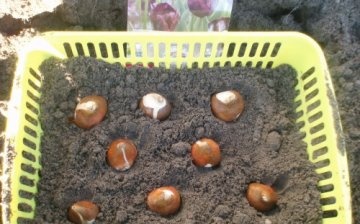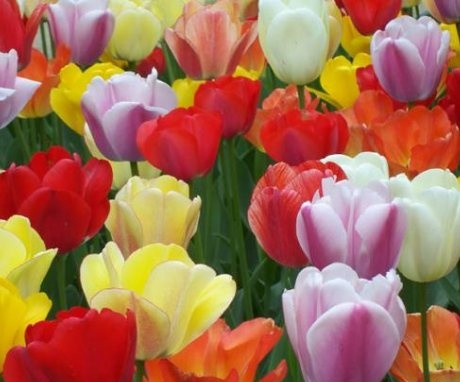Growing tulips at home: tips and rules
Tulips are truly charming flowers that have long become symbols of spring and joy. However, they can be grown not only in the garden or in the front garden, but also at home, and in this case there is no need to wait for spring to admire the magnificent buds. Tulips have become one of the most popular bulbous plants used for home forcing. Although it is a rather unpretentious flower, growing tulips at home has its own nuances.
Content
- Selection of variety and planting material
- Planting tulips at home
- Growing tulips and preparing for flowering
- Some tips for growing tulips
Selection of variety and planting material
Not everything can be grown at home tulip varieties, since some of them are very demanding on the conditions created.
The best options for a window sill:
- Aristocrat.
- London.
- Lustig Battle.
- Parade.
The Parad Record variety is suitable even for novice florists, as it is quite unpretentious, and it is not difficult to create suitable conditions for it. For home cultivation, it is better to choose undersized varieties, since they are less susceptible to various diseases. At home, the leaves suffer from microorganisms, so it is better to choose the most resistant varieties.
An important stage is the choice of seed, most of the result will depend on it.
You can buy it at a flower shop, or you can dig up the bulbs on site and use them for home distillation. In the first case, the probability of a good result is more likely: the bulbs are properly processed, and during their storage, the correct conditions were ensured to ensure maximum germination. However, it is possible to independently prepare seed without much difficulty. To do this, you need to do the following:
During the growing season, the bulbs are carefully looked after:
- It is necessary to loosen the ground regularly.
- Remove weeds.
- Observe a uniform watering frequency.
- When the stems begin to turn yellow, the bulbs are dug out of the flower bed.
- The largest bulbs should be dried in a warm room.
Initially, they are kept for a week at a temperature of about 34 degrees, then for 2 months they are stored at a temperature of just over 20 degrees, and then placed in an even cooler room, where the air warms up only to 17 degrees.
After aging, the planting material is removed into boxes or gauze bags, after which it must be stored in the refrigerator (temperatures not higher than +5 degrees).
As a result, the bulbs will undergo sufficient preparation for planting, and they are guaranteed good germination. You will be able to see the first flowers very soon.
Planting tulips at home
The technology of forcing bulbs at home assumes that plants need to create an artificial environment that is completely close to natural.
It is for this that the bulbs must go through a cooling stage. Tulip in nature germinates in spring after snow melts, that is, after a long winter rest. By adjusting the temperature in an artificial environment, you can prepare the bulbs for germination at any time, so you can admire the magnificent buds even in the middle of a harsh winter.
An excellent time to plant is early September.
At this time, autumn plants are blooming, and your tulips will bloom when the flower beds in the garden are already covered with snow. How to plant tulips?
An approximate instruction for planting bulbs in pots looks like this:
- Prepare soil boxes, their depth should be at least 15 cm. It is very convenient to use plastic containers for growing.
- Prepare a soil substrate that includes river sand, turf and humus in a 1: 2: 1 ratio. It is also recommended to add a small amount of ash to the soil. At the flower shop, you can buy ready-made soil that is ideal for these plants.
- Sort out the seed: the bulbs must be healthy, free of mold and signs of rot. Before planting, they are immersed in a pale pink solution of potassium permanganate for half an hour to prevent various diseases.
- In containers for planting, you need to make a drainage layer so that the water does not start to stagnate. For this, you can use sphagnum moss, expanded clay or other similar material.
- Fill the container about half with soil.
- Lay out the planting material in rows, the distance between the bulbs should be about 1 cm.
- Cover the bulbs with soil up to the level of the tops. The soil must be well watered, and when the earth settles, the required amount of the substrate is added.
- The pots with planted bulbs are left in a dark, cool room, the temperature in it should not reach 10 degrees.
This will create conditions close to natural conditions, and as a result, the bulbs will sprout quickly.
Growing tulips and preparing for flowering
How to grow tulips at home:
- Planting boxes need to be watered periodically.
- Usually, once a week is enough, so that mold does not start to appear on the ground.
- After about 2-3 weeks, you will see the first shoots.
- When they grow to the level of 6-7 centimeters, the boxes can be moved into the room.
- Since they are not yet accustomed to daylight, they will need to be gradually accustomed.
- At first, the sprouts are covered with paper caps.
- The air temperature should also rise gradually, if possible. Remember, in nature, spring does not come immediately, and at least a few days the plants must be kept at a temperature of 18-20 degrees.
If you immediately keep the plants in normal indoor conditions, the flower stalks will turn out to be very thin and weak, and this will not allow the buds to gain strength. In addition, a disease such as fusarium is possible, in which the leaves that have appeared are affected.
- Plants need provide good lighting.
- The room usually requires lamps that should shine for at least 10 hours, since there will not be enough light from the window. Lack of light leads to the fact that the stems will be very stretched, and the petals will turn out to be too pale, so it is worth taking care of the organization of the lighting.
- After the buds appear, it is better to place the tulip boxes in a cooler place, for example, to a cold window glass. The low temperature will allow the buds to bloom for much longer, delighting you with exquisite, beautiful petals.
- To further prolong flowering, plants need to be regularly sprayed, Tulips do not like dry air, the normal humidity level in nature for them is about 80%. When spraying, it is important to make sure that no water gets on the buds themselves, as they can fade.
It is not very easy to create ideal conditions for a tulip in an apartment, however, if you wish, you can organize a mini-greenhouse at home, in which the required temperature and lighting regime will be maintained.
Some tips for growing tulips
While this is not a very moody plant, it is important to know a few subtleties.
They are also useful for growing other varieties of bulbous plants at home:
- It is not recommended to take tap water for irrigation.It should be allowed to stand for at least 24 hours before it becomes safe and beneficial for flowers. The water temperature should be room temperature, about 20 degrees.
- To make the tulip grow faster, you can apply a little liquid fertilizer to the soil.
- Do not allow direct sunlight to fall on tulip sprouts and buds. Sunburn can cause the petals to just start to crumble. It is better to place the tulip where there is no bright sun, but where good illumination is attainable.
- Tulips need to be protected from drafts. Do not place them under open vents; be careful when ventilating. Plants get sick in the same way as people, and violations of the temperature regime can lead to sad consequences.
- It is not recommended to place flower pots near radiators. This will quickly overheat, and the tulip will not bloom, as the natural cycle will be disrupted.
- It is better to cut flowers in the morning before watering. They are carefully trimmed near the bulb itself and placed with the ends in water. You will be able to decorate the whole house with festive bright buds.
- When the petals crumble and flowering stops, the peduncles break off, and the bulbs gradually stop watering.
- Over time, the leaves will begin to turn yellow and dry, after which the bulb must be dug up and sent for storage.
- Bulbs that have been used to grow tulips at home cannot be re-planted at home. They are severely depleted, and re-flowering can not be expected. But they can be planted again on the site, and then they will fully recover within a year or several years. Perhaps they are already next year will give buds again.
Tulips - favorite spring flowers, which are able to truly decorate the house, bringing a sense of joy and renewal to it. It is all the more pleasant to look at the magnificent multi-colored buds in winter or late autumn, when there are few bright colors around. Forcing tulips at home is not particularly difficult, and even a novice gardener can handle it.
More information can be found in the video.

















I slightly disagree with the last paragraph of the section "A few tips for growing tulips". It depends on which variety was grown at home. There are tulips that bloom well even after growing in a basket or flowerpot in the wrong season. Here you need to watch and experiment.
I always wanted to grow tulips at home to please loved ones with an unusual souvenir. I will use your advice with pleasure, as autumn has come. Thank you!